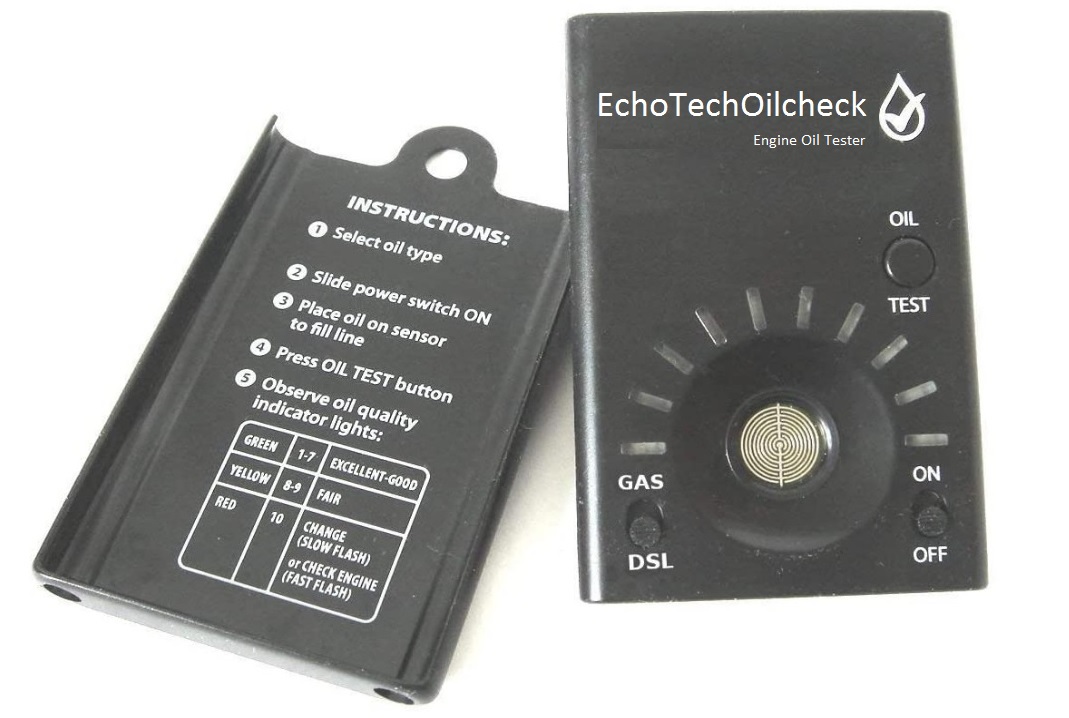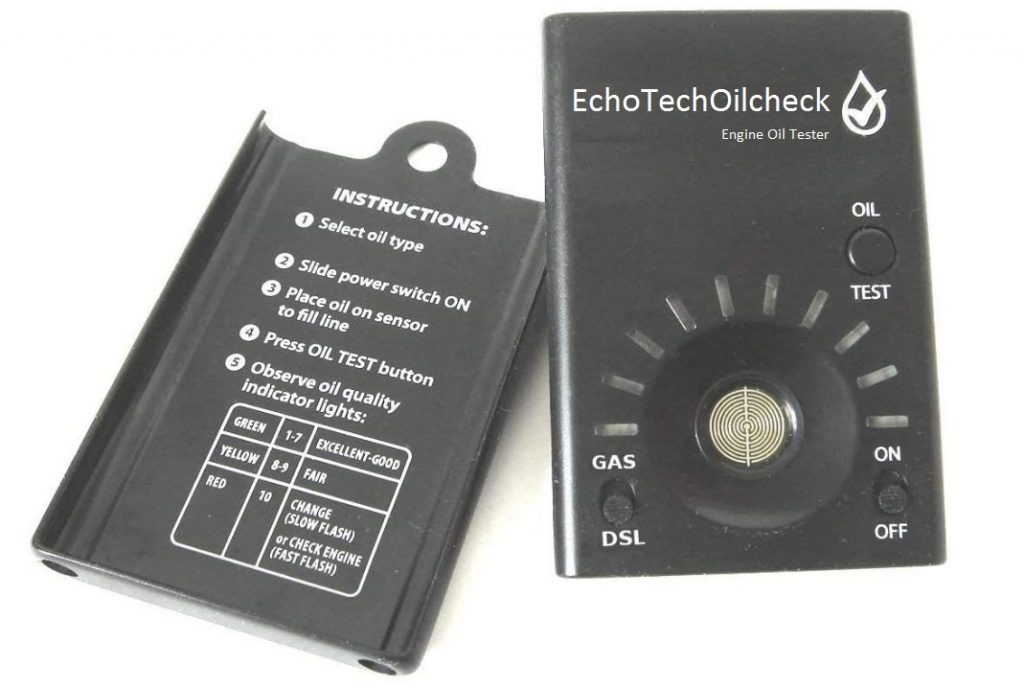
Learn about the EchoTechOilCheck Oil Testers facts, technology, sciences resources and environment
The 3,000 Mile Oil Change Myth Over Frequent Oil Changes:
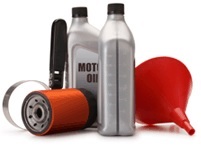
The advice to change oil every 3000 to 5000 miles has been ingrained in most of us by oil companies and service stations since WWII. Over the past 50 years, automotive and oil technology has advanced significantly, making it possible to dramatically extend intervals between oil changes.
Automotive manufacturers such as BMW, Mercedes Benz, Ford, Toyota, General Motors, Mazda, Audi, and others are producing new vehicles with engine oil quality sensors, or other methods to estimate oil quality. The use of these systems have resulted in a dramatic reduction in the frequency of oil changes, while maintaining excellent engine health over the life of the vehicle.
Automotive manufacturers such as BMW, Mercedes Benz, Ford, Toyota, General Motors, Mazda, Audi, and others are producing new vehicles with engine oil quality sensors, or other methods to estimate oil quality. The use of these systems have resulted in a dramatic reduction in the frequency of oil changes, while maintaining excellent engine health over the life of the vehicle.
EchoTechOilCheck’s Automotive Solution:
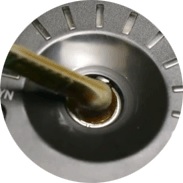
Now, Echo Tech have a scientifically proven, hand held technology that empowers you with the same technical results found in many new autos, and more.
Simply driving longer without an oil change is not the solution. Not knowing the quality of the oil in between changes can put the health of your engine at risk.
EchoTechOilCheck eliminates the risk of extending your oil changes by allowing you to scientifically analyze your oil quality at any time, providing you immediate results. It also tests for any sudden or unexplained drop in oil quality caused by impurities in the oil system, such as coolant leaks, water, and metal particulates. It’s like a ‘blood tester’ for your vehicle.
3000 Mile Oil Changes Debunked:
Although the automotive industry, state and federal governments, public interest groups and private research companies (like Echo Tech) are attempting to debunk this 3000 mile oil change myth, big oil companies and oil lube services are slow to educate the public, for very obvious reasons.
Clearly, a reduction in oil consumption by the public is not in their financial interest!
The Challenge:
We invite you to web search this question yourself! See if you can find information to support low mileage oil changes in modern vehicles. We’ve also provided links by independent institutions here on this website supporting monitored oil changes.
The Science
Superior Engine Lubrication Technology
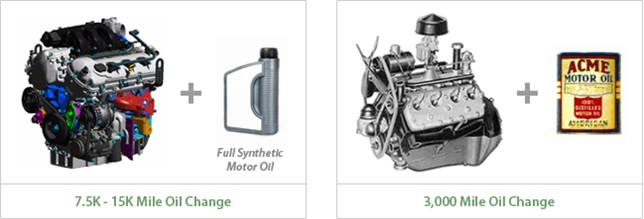
Many private companies and public institutions have spent years researching consumer oil use patterns and the useful life of motor oil. Even a casual review of this literature will reveal some startling findings, such as:
– Numerous scientific papers recommend 15K mile plus oil change intervals for most modern vehicles made today.
– Many vehicle owners, and surprisingly, many automotive experts, rely on the invalid method of oil opacity, or oil coloration and darkness to gauge their engine oil condition.
Of course, changing oil based solely on mileage is the standard most motorists follow. But this approach fails to take into account driving habits, climate, traffic conditions, engine condition, oil type, etc. Because these variables are so difficult to evaluate and quantify, experts have historically advocated frequent oil changes, just to be on the ‘safe side’.
A point where researchers agree is on the validity and advisability of oil laboratory tests to determine actual oil condition. Since the cost of oil testing equipment has been prohibitive for motorists, and even for most fleet managers, oil samples must be collected from the vehicle and mailed to a lab. This requires:
– Purchasing an oil sample kit from an oil test lab for $20 plus dollars
– Draining a portion of the oil to collect a several oz. sample
– Mailing the sample to a distant oil lab
– Waiting a week or more for the results
Given the cost and hassle of using professional testing labs, it is obvious why most motorists don’t bother with this option.
Knowing Oil Quality Metrics
The most important factors in determining engine oil quality are:
1. Acidity
High acidity content in engine oil causes “pitting”, or the eating away of the inner metal surfaces in your engine. This problem is very common, and eventually causes reduced engine performance, excessive oil use, poor fuel economy, and loss of power.
2. Metal
Particulates Metal particulates are also a concern and often indicate rapid wear of bearing, cylinder wall and piston surfaces.
3. Carbonized Particulates
The dark color in oil is caused by engine combustion and is NORMAL. Carbon deposits caused by the combustion cycle are “suspended” in the oil, causing a dark color over time. But this means that the oil is doing its job.
4. Foreign liquids (coolant leaks, water leaks)
Liquids such as coolant and water are detrimental to engines, and can be a major source of internal corrosion. Their presence in oil is an indication of potentially serious engine problems. Catching their presence early will likely save on substantial repair bills. EchoTechOilCheck tests for all these variables in the chemistry of the oil. It is a one stop “laboratory on a chip” and provides scientific evidence of your vehicles health at any given time.
Total Base Number
The TBN (Total Base Number) is a scientific metric used by the oil analysis industry to determine the pH level (or acidity) of the oil. As mentioned earlier, high acidity is detrimental to the performance and life of the engine.
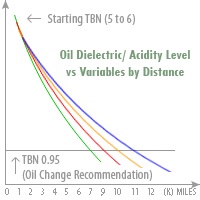
The base level can be measured conveniently and quickly with the EchoTechOilCheck. In addition, EchoTechOilCheck will also react to the presence water, coolant, carbon and metal particulates that may be present in the oil.
The Technology
Physics and Chemistry
EchoTechOilCheck analyzes a physical property inherent in every tangible object in the universe. It is called the “dielectric” or “permittivity” property of a molecular structure. EchoTechOilCheck also measures the high impedance (resistivity) of the oil sample for high carbon content, and metals.

The combination of these two physics principles allows for an accurate measurement of the quality of engine oil. The EchoTechOilCheck combines the measurement data for acidity, metal particulate level, carbon level and foreign liquids (except fuel) into one, easy to understand rating of your oil condition.
Determining Oil Quality
Changing oil based solely on miles driven fails to take any of the following important variables into account:
1 Engine condition (poor, fair, good)
2 Driving habits (fast, slow, steady, rapid acceleration, frequent speed changes, number of cold starts, etc.)
3 Environmental conditions (hot, dry, humid, cold, mountains, hills, city vs highway, etc.)
4 Oil type (standard, synthetic, manufacturer’s oil quality and additives used)
Up until now, the only way to really know when engine oil needed to be changed was to have an oil sample tested by an oil lab, or by using expensive, industrial type oil testers.
Now, for the first time, consumers have the option of actually testing their own oil with the EchoTechOilCheck. Additionally, with data collected over time, your mechanic or auto tech has a better chance of identifying problems early, before expensive repairs are needed.
Determining Oil Quality
Your test results are instantly displayed by one of the 10 LEDs on the EchoTechOilCheck.
Green (1-7) means good, amber (8-9) means fair, and red (10) warns you it is time for a change! (A rapidly flashing #10 LED means potential engine problems).

It’s just that simple!
